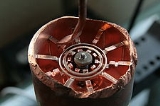
Cavity magnetron
Overview
Vacuum tube
In electronics, a vacuum tube, electron tube , or thermionic valve , reduced to simply "tube" or "valve" in everyday parlance, is a device that relies on the flow of electric current through a vacuum...
that generates microwave
Microwave
Microwaves, a subset of radio waves, have wavelengths ranging from as long as one meter to as short as one millimeter, or equivalently, with frequencies between 300 MHz and 300 GHz. This broad definition includes both UHF and EHF , and various sources use different boundaries...
s using the interaction of a stream of electrons with a magnetic field. The 'resonant' cavity magnetron variant of the earlier magnetron tube was invented by John Randall
John Randall (physicist)
Sir John Turton Randall, FRS, FRSE, was a British physicist and biophysicist, credited with radical improvement of the cavity magnetron, an essential component of centimetric wavelength radar, which was one of the keys to the Allied victory in the Second World War. It is also the key component of...
and Harry Boot
Harry Boot
Henry Albert Howard "Harry" Boot was an English physicist who with Sir John Randall and James Sayers developed the cavity magnetron, which was one of the keys to the Allied victory in the Second World War.-Biography:...
in 1940 at the University of Birmingham, England. The high power of pulses from the cavity magnetron made centimeter-band radar
Radar
Radar is an object-detection system which uses radio waves to determine the range, altitude, direction, or speed of objects. It can be used to detect aircraft, ships, spacecraft, guided missiles, motor vehicles, weather formations, and terrain. The radar dish or antenna transmits pulses of radio...
practical. Shorter wavelength radars allowed detection of smaller objects.
Unanswered Questions

